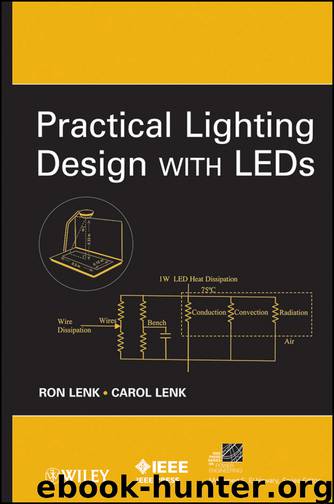Practical Lighting Design with LEDs by Lenk Ron Lenk Carol & Carol Lenk

Author:Lenk, Ron, Lenk, Carol & Carol Lenk
Language: eng
Format: epub
Publisher: John Wiley & Sons
Published: 2011-04-11T16:00:00+00:00
We’ll make a brief comment on EMI standards in the United States versus those in the European Union (EU). These standards are fundamentally very similar. The only significant difference at this time is that the EU also has a limitation on power line harmonics, EN61000-3-2. Chances are that if your design passes EMI, it probably will pass this standard as well.
Finally, let’s comment on selecting the switching frequency of your SMPS. The reason for including these comments is that SMPS switching is often the most important source of EMI in a system. Now the fundamental consideration is that EMI conducted limits start at 150 KHz. Below that frequency, you can have as much noise power as you like (subject to limits on harmonic content). Above 150 KHz, the amount of noise allowed decreases at 30 dB/decade, which is faster than a one-pole filter but slower than a two-pole filter. So the most sensible choices are either to switch below 150 KHz or else be considerably above that frequency. Switching at 200 KHz, for example, gives you the worst of both worlds.
You will also have to pass radiated emissions. The limits for this start at 30 MHz, so that the emissions don’t directly impact switching frequency selection. However, switching at high frequencies requires transitions between on and off in the power elements to be fast. If your switching frequency is 1MHz, the on-time of the transistor is less than 1 µsec, and so it needs to turn on and off in less than 30 nsec to avoid big losses. These transitions are within the regulated radiated bands. If instead your switching frequency is 100 KHz, the transition times can be 10 times slower.
From an EMI perspective, a switching frequency below 150 KHz is going to be best. With lower frequencies, the downside is that component sizes get bigger. This is true particularly of inductors and capacitors. You can do a lot of math to find out that there’s no one best answer; there are too many factors to consider and optimize. Our practical recommendation is this: pick a switching frequency just below 150 KHz (including component tolerances) or above 1 MHz. If size isn’t an issue, the lower of these two is probably the better choice, and will be more efficient anyway.
Download
This site does not store any files on its server. We only index and link to content provided by other sites. Please contact the content providers to delete copyright contents if any and email us, we'll remove relevant links or contents immediately.
| Circuits | Digital Design |
| Electric Machinery & Motors | Electronics |
| Fiber Optics | Networks |
| Superconductivity |
Whiskies Galore by Ian Buxton(41493)
Introduction to Aircraft Design (Cambridge Aerospace Series) by John P. Fielding(32863)
Small Unmanned Fixed-wing Aircraft Design by Andrew J. Keane Andras Sobester James P. Scanlan & András Sóbester & James P. Scanlan(32536)
Craft Beer for the Homebrewer by Michael Agnew(17905)
Turbulence by E. J. Noyes(7665)
The Complete Stick Figure Physics Tutorials by Allen Sarah(7099)
Kaplan MCAT General Chemistry Review by Kaplan(6550)
The Thirst by Nesbo Jo(6409)
Bad Blood by John Carreyrou(6247)
Modelling of Convective Heat and Mass Transfer in Rotating Flows by Igor V. Shevchuk(6209)
Learning SQL by Alan Beaulieu(5997)
Weapons of Math Destruction by Cathy O'Neil(5783)
Man-made Catastrophes and Risk Information Concealment by Dmitry Chernov & Didier Sornette(5597)
Digital Minimalism by Cal Newport;(5328)
Life 3.0: Being Human in the Age of Artificial Intelligence by Tegmark Max(5152)
iGen by Jean M. Twenge(5129)
Secrets of Antigravity Propulsion: Tesla, UFOs, and Classified Aerospace Technology by Ph.D. Paul A. Laviolette(4869)
Design of Trajectory Optimization Approach for Space Maneuver Vehicle Skip Entry Problems by Runqi Chai & Al Savvaris & Antonios Tsourdos & Senchun Chai(4811)
Electronic Devices & Circuits by Jacob Millman & Christos C. Halkias(4706)
